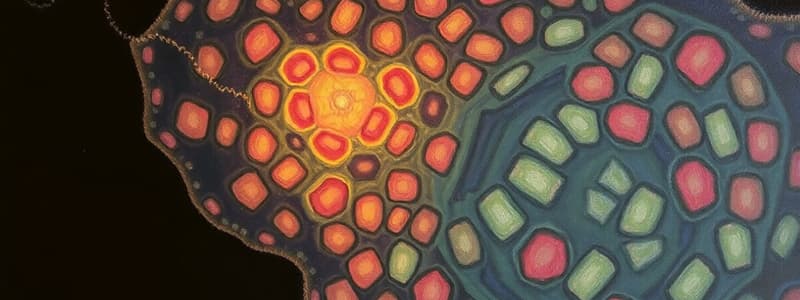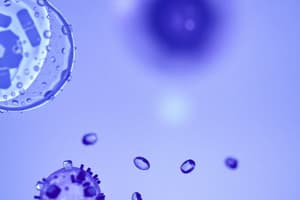Podcast
Questions and Answers
What distinguishes eukaryotic cells from prokaryotic cells?
What distinguishes eukaryotic cells from prokaryotic cells?
- Prokaryotic cells lack a plasma membrane.
- Eukaryotic cells have a membrane-bound nucleus. (correct)
- Prokaryotic cells contain organelles.
- Eukaryotic cells do not have DNA.
Which organelle is specifically responsible for producing energy in eukaryotic cells?
Which organelle is specifically responsible for producing energy in eukaryotic cells?
- Mitochondria (correct)
- Ribosome
- Nucleus
- Lysosome
Which of the following is NOT a feature of prokaryotic cells?
Which of the following is NOT a feature of prokaryotic cells?
- Possess membrane-bound organelles (correct)
- Contain ribosomes
- Lack a membrane-bound nucleus
- Have a nucleoid region
What is the primary function of the Golgi Apparatus in eukaryotic cells?
What is the primary function of the Golgi Apparatus in eukaryotic cells?
Which component of the plasma membrane is involved in receiving signals?
Which component of the plasma membrane is involved in receiving signals?
Which of the following characteristics is common to all cells?
Which of the following characteristics is common to all cells?
Which organelle is primarily involved in the synthesis of lipids?
Which organelle is primarily involved in the synthesis of lipids?
In plant cells, which organelle is responsible for conducting photosynthesis?
In plant cells, which organelle is responsible for conducting photosynthesis?
Which statement best describes the cell?
Which statement best describes the cell?
What does the term 'cytosol' refer to?
What does the term 'cytosol' refer to?
Which characteristic is true of prokaryotic cells?
Which characteristic is true of prokaryotic cells?
How do all cells derive from existing cells?
How do all cells derive from existing cells?
Which component is found in all cells?
Which component is found in all cells?
What is the primary difference between cytoplasm and cytosol?
What is the primary difference between cytoplasm and cytosol?
Which statement accurately describes eukaryotic cells?
Which statement accurately describes eukaryotic cells?
What is a key feature of cell theory?
What is a key feature of cell theory?
What primary component makes up the cell's plasma membrane?
What primary component makes up the cell's plasma membrane?
Which statement best describes the function of the plasma membrane?
Which statement best describes the function of the plasma membrane?
Which characteristic of phospholipids contributes to the formation of the bilayer structure?
Which characteristic of phospholipids contributes to the formation of the bilayer structure?
What is the thickness of the plasma membrane?
What is the thickness of the plasma membrane?
Which model describes the structure of the plasma membrane?
Which model describes the structure of the plasma membrane?
In the Fluid Mosaic Model, the 'mosaic' refers to what aspect of the membrane?
In the Fluid Mosaic Model, the 'mosaic' refers to what aspect of the membrane?
What role does cholesterol play in animal cell membranes?
What role does cholesterol play in animal cell membranes?
Why are phospholipids described as amphipathic?
Why are phospholipids described as amphipathic?
What is the primary reason for membrane fluidity in cellular membranes?
What is the primary reason for membrane fluidity in cellular membranes?
Which of the following statements about integral membrane proteins is TRUE?
Which of the following statements about integral membrane proteins is TRUE?
What role do membrane proteins serve in the cellular membrane?
What role do membrane proteins serve in the cellular membrane?
How does cholesterol contribute to the composition of animal cell membranes?
How does cholesterol contribute to the composition of animal cell membranes?
What distinguishes peripheral membrane proteins from integral membrane proteins?
What distinguishes peripheral membrane proteins from integral membrane proteins?
At what percentage can membrane proteins comprise of the plasma membrane mass?
At what percentage can membrane proteins comprise of the plasma membrane mass?
Which of the following best describes the behavior of proteins within the cellular membrane?
Which of the following best describes the behavior of proteins within the cellular membrane?
What factor can decrease the melting point of lipids in a membrane?
What factor can decrease the melting point of lipids in a membrane?
Flashcards are hidden until you start studying
Study Notes
The Cell
- A cell is an autonomous self-replicating unit that can exist independently (single-celled organisms) or contribute to a multicellular organism.
- Cells represent the fundamental unit of life, capable of performing all life activities.
- All organisms are composed of cells and cells arise from pre-existing cells (Cell Theory).
General Cell Properties
- A plasma membrane encloses all cells, acting as a selectively permeable barrier.
- Cytoplasm fills the space within the membrane, containing the cell's internal components.
- Chromosomes, composed of DNA and containing genetic information, are present at some point in a cell's lifecycle.
- All cells possess ribosomes, which synthesize proteins based on instructions from genes.
Cells and Their Interior
- Cytoplasm encompasses all material within the cell, excluding the nucleus, and comprises organelles.
- Cytosol refers to the material within the cytoplasm, excluding membranous organelles.
- Organelles are distinct compartments within the cell, each specialized for specific metabolic processes.
Categorizing Cells
- Cells are classified into prokaryotes and eukaryotes based on their structural organization.
- Prokaryotes lack a nucleus and internal compartmentalization (no membrane-bound organelles).
- Eukaryotes possess a nucleus and internal membrane-bound organelles.
Prokaryotes and Eukaryotes
- Prokaryotes belong to the Bacteria and Archaebacteria domains and are simpler in structure.
- Eukaryotes belong to the Animalia, Plantae, Protista, and Fungi kingdoms and have complex internal organization.
- Prokaryotic genetic material is located in a nucleoid region, while eukaryotic DNA is enclosed within a nucleus.
Organelles: The Cell's Functional Units
- Organelles function together to maintain the cell's structure and perform its functions effectively.
- Most organelles are membrane-bound, except for ribosomes.
Nucleus: The Cell's Control Center
- The nucleus houses the cell's DNA and is responsible for coordinating crucial activities like growth, metabolism, and reproduction.
Mitochondria: The Energy Powerhouse
- Mitochondria generate energy through cellular respiration, producing ATP, the cell's energy currency.
Ribosomes: Protein Synthesis Factories
- Ribosomes, present in both prokaryotes and eukaryotes, are responsible for protein synthesis.
Endoplasmic Reticulum: Protein and Lipid Synthesis
- The endoplasmic reticulum, in both rough and smooth forms, participates in protein and lipid synthesis.
Golgi Apparatus: Processing and Packaging
- The Golgi apparatus modifies, sorts, and packages proteins and lipids for secretion.
Lysosomes: Cellular Digestion
- Lysosomes act as the cell's digestive system, breaking down cellular waste and macromolecules.
Chloroplasts: Photosynthesis Powerhouses
- Chloroplasts, found in plant cells, conduct photosynthesis, converting light energy into chemical energy (glucose).
Cell Size and Fluidity
- Most cells are microscopically small, although exceptions exist (bird eggs, neurons, some algal cells).
- The plasma membrane is a dynamic structure, composed of a phospholipid bilayer, and is responsible for the cell's selective permeability.
Phospholipid Bilayers: The Foundation of Membranes
- Plasma membranes are primarily composed of phospholipids, with the presence of cholesterol in animal cells.
- Phospholipids are amphipathic molecules, possessing both hydrophilic heads and hydrophobic tail regions.
- The arrangement of phospholipids in a bilayer allows for selective permeability and flexibility.
- The fluid mosaic model describes the cell membrane as a fluid structure with proteins embedded within the phospholipid bilayer, contributing to its functionality.
Membrane Fluidity and Composition
- Membrane fluidity is influenced by temperature and lipid composition, impacting the movement of molecules within the membrane.
Membrane Proteins: Functional Diversity
- Proteins embedded within the membrane contribute significantly to the cell's functions, composing a substantial proportion of its mass.
- Integral membrane proteins possess both hydrophobic and hydrophilic regions, interacting with the lipid bilayer.
- Peripheral membrane proteins lack exposed hydrophobic groups and do not penetrate the bilayer.
Membrane Proteins and Their Roles
- Membrane proteins perform diverse functions, including:
- Transporting ions and molecules across the membrane.
- Acting as receptors to receive environmental signals.
- Catalyzing chemical reactions within the cell as enzymes.
Studying That Suits You
Use AI to generate personalized quizzes and flashcards to suit your learning preferences.




